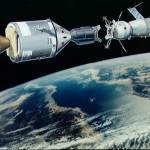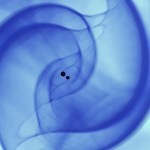Dominique Luchart's Blog, page 566
July 16, 2021
Can we solve the black hole information paradox with ‘photon spheres’?, ,

Are black holes as simple as they appear, or is there more to their story?
Theories that attempt to resolve the so-called black hole information paradox predict that black holes are much more complicated than general relativity suggests. Future observations of photon spheres — swirling bands of light around the edges of black holes — will be able to test these theories.
According to Albert Einstein’s theory of general relativity, black holes are surprisingly simple. If you know the mass, charge and spin of a black hole, you know everything there is to know about it. In fact, black holes are some of the simplest and most straightforward characters in the universe.
But that apparent simplicity gives rise to a troubling paradox. In the 1970s, famed astrophysicist Stephen Hawking realized that black holes aren’t completely black. Instead, they emit radiation through a subtle quantum mechanical process operating at their event horizons, or the boundaries of black holes where nothing, not even light, can escape.
Because black holes are so simple and can be described with only three numbers, all the information about the material that falls into black holes is seemingly locked away forever. It doesn’t matter if you build a black hole out of dead stars and interstellar dust or a black hole out of cats; as long as those two black holes have the same spin, mass and charge, they will be identical.
In Hawking’s original formulation of his radiation process, that radiation carried no information away with it. But as the black hole emits radiation, it evaporates, eventually disappearing altogether — hence the so-called black hole information paradox. If a bunch of information falls into a black hole, and information can’t be destroyed, then when the black hole disappears, where does all the information go?
Video: Scientists find clump of black holes inside the heart of globular cluster
Look to the lightOver the past few decades, there have been many attempts to solve the information paradox. Some of those proposals involve extending our knowledge of general relativity. Some involve attempts to marry general relativity with our understanding of quantum mechanics. And some are just downright strange.
As of yet, however, all attempts to solve the information paradox are unproven. It’s very difficult to observe black holes directly, as we usually see them only when they interact with their surroundings (usually by swallowing large clumps of gas or dust) or when they merge and release gravitational waves.
But all that changed in 2019, when a global network of telescopes known as the Event Horizon Telescope worked in concert to deliver a single image of M87*, a supermassive black hole in the center of the Virgo galaxy.
That image is striking and haunting. The dark void at the center is the shadow cast by the black hole’s event horizon, preventing any light behind the black hole from piercing through. And that void is surrounded by a ghostly ring of light emitted by the superheated plasma surrounding the black hole.
Ring of fireWhat can this image tell us about the true nature of black hole event horizons?
The event horizon of the black hole itself is far smaller than its shadow; the shadow appears so big because of the extreme bending of space near the black hole. And lying somewhere between that event horizon and the edge of the shadow is an interesting feature that also results from the extreme bending of space: the photon sphere. The photon sphere is a region near a black hole where the gravity is so strong that light itself can orbit around the black hole.
The orbits in that region are unstable; the photons can loop around the black hole a few times, but they will not stay forever. Eventually, they will leak out, giving rise to a thin, visible ring of light around the black hole.
In classical general relativity, that photon sphere is so thin that it barely even exists and is far too faint to be seen in the image of M87* taken with the Event Horizon Telescope.
Now, a team of researchers has investigated the properties of the photon sphere in theories that attempt to solve the black hole information paradox. They found that some complex theories of black hole event horizons influence their surrounding environment, including the photon sphere. In some of these theories, it’s possible for the photon sphere to be far wider, and thus far brighter, to distant observers, the team wrote in a paper published recently to the preprint database arXiv.
Despite the change, the differences in the photon spheres between classical relativity and the predictions of these exotic models are still too small to be seen with the Event Horizon Telescope. But that telescope’s incredible image will not be the last picture we take of a black hole. Future attempts to study M87* and other supermassive black holes will deliver higher-resolution images. If we can resolve the photon ring, studying its width and brightness will give us clues as to the nature of the event horizon and, ultimately, how to resolve the black hole information paradox.
Learn more by listening to the episode “Could we really terraform Mars?” on the Ask A Spaceman podcast, available on iTunes and on the Web at http://www.askaspaceman.com. Ask your own question on Twitter using #AskASpaceman or by following Paul @PaulMattSutter and facebook.com/PaulMattSutter.
The post Can we solve the black hole information paradox with ‘photon spheres’?, , appeared first on NEWDAWN Blog.
Space Chat with Space.com: Blue Origin prepares to launch, Virgin Galactic launches and crazy space science!, ,

Today (July 16), Space Chat will explore what’s new in space, including Blue Origin and Virgin Galactic’s suborbital spaceflights, giant megacomets and more!
Do you want to know what’s going on in space?
Every Friday at 1 p.m. EDT (1800 GMT), Space.com senior writer Chelsea Gohd explores what’s new in space on Space Chat, which you can find live on Space.com’s Facebook page and Youtube page.
Do you have space questions you want to be answered?
Ask Gohd your questions on Facebook or Youtube and get them answered LIVE during Space Chat every Friday.
Related: Science & Astronomy News at Space.com
If there’s something happening in space that you want to ask questions about on the next episode of Space Chat, you can post your suggestion for future episode topics to any of Space.com’s social media channels.
Also, if you’re looking to stay actively involved in the Space.com community, feel free to chat with other space enthusiasts over in our Space.com Forums here.
The 12 Strangest Objects in the UniverseFrom Big Bang to Present: Snapshots of Our Universe Through Time.The 11 Biggest Unanswered Questions About Dark MatterFollow Chelsea Gohd on Twitter @chelsea_gohd . Follow us on Twitter @Spacedotcom and on Facebook .
Join our Space Forums to keep talking space on the latest missions, night sky and more! And if you have a news tip, correction or comment, let us know at: community@space.com.
The post Space Chat with Space.com: Blue Origin prepares to launch, Virgin Galactic launches and crazy space science!, , appeared first on NEWDAWN Blog.
Space weather is difficult to predict — with only an hour to prevent disasters on Earth, ,

This article was originally published at The Conversation. The publication contributed the article to Space.com’s Expert Voices: Op-Ed & Insights .
Martin Gerard Connors , Professor of Space Science and Physics, Athabasca University
Recent developments at the forefront of astronomy allow us to observe that planets orbiting other stars have weather. Indeed, we have known that other planets in our own solar system have weather, in many cases more extreme than our own.
Our lives are affected by short-term atmospheric variations of weather on Earth, and we fear that longer-term climate change will also have a large impact. The recently coined term “space weather” refers to effects that arise in space but affect Earth and regions around it. More subtle than meteorological weather, space weather usually acts on technological systems, and has potential impacts that range from communication disruption to power grid failures.
Read more: Solar weather has real, material effects on Earth
An ability to predict space weather is an essential tool in providing warnings so that mitigation can be attempted, and to hopefully, in extreme cases, forestall a disaster.
The history of weather forecastingWe are now used to large-scale meteorological forecasts that are quite accurate for about a two-week timescale.
Scientific weather forecasting originated about a century ago, with the term “front” being associated with the First World War. Meteorological prediction is based on a good knowledge of underlying theory, codified into massive computer programs running on the most advanced computers, with huge amounts of input data.
Important aspects of weather, like moisture content, can be measured by satellites that monitor continuously. Other measurements are also be readily taken, for example, by the nearly 2,000 weather balloons launched each day. Exploring the limits in weather forecasting gave rise to chaos theory, sometimes called the “butterfly effect.” The buildup of error brings about the two-week practical limit.
In contrast, the prediction of space weather is only truly reliable about one hour in advance!
Solar effectsMost space weather originates from the sun. Its outermost atmosphere blows into space at supersonic speeds, although at such low density that interplanetary space is more rarified than what is considered a vacuum in our laboratories. Unlike winds on Earth, this solar wind carries along a magnetic field. This is much smaller than Earth’s own field that we can detect with a compass at the surface, and vastly smaller than that near a fridge magnet, but it can interact with Earth, with an important role in space weather.
The very thin solar wind, with a very weak magnetic field, can nevertheless affect Earth in part because it interacts with a large magnetic bubble around Earth, called the magnetosphere, over a very large area, at least a hundred times as big as the surface of our planet. Much like a breeze that can barely move a thread can move a huge sailing ship when caught on the large sails, the effect of solar wind, through its direct pressure (like on a sail) or through its magnetic field interacting with Earth’s, can be enormous.
As the origin point, the sun itself is a seething mass of hot gas and magnetic fields, and their interaction is complex, sometimes even explosive. Magnetic fields are concentrated near sunspots, and produce electromagnetic phenomena like solar flares (the name says it all) and coronal mass ejections. Much as with tornadoes on Earth, we know generally when conditions are favorable for these localized explosions, but precise prediction is difficult.
Even once an event is detected, if a large mass of fast, hot and dense gas is shot in our direction (and such a “cloud” in turn is difficult to detect, coming at us against the glare of the sun), there is a further complicating factor in predicting its danger.
Detecting magnetic fieldsUnlike the detectable, sometimes even visible, water content in the atmosphere that is so important in meteorology, the magnetic field of gas ejected from the sun, including in hot and denser clouds from explosions, is almost impossible to detect from afar. The effect of an interplanetary cloud is greatly enhanced if the direction of its magnetic field is opposite to Earth’s own field where it hits the barrier of Earth’s magnetosphere. In that case, a process known as “reconnection” allows much of the cloud’s energy to be transferred to the region near Earth, and accumulate largely on the night side, despite the cloud hitting on the side facing the sun.
By secondary processes, usually involving further reconnection, this energy produces space weather effects. Earth’s radiation belts can be greatly energized, endangering astronauts and even satellites. These processes can also produce bright auroras, whose beauty hides danger since they in turn produce magnetic fields. A generator effect takes place when dancing auroras make magnetic fields vary, but unlike in the generators that produce much of our electricity, the electric fields from auroras are uncontrolled.
The electric fields from auroras are small, and undetectable to human senses. However, over a very large region they can build up to apply a considerable voltage. It’s this effect that poses a hazard to our largest infrastructure, such as electric grids. To predict when this might happen, we would need to measure from afar the size and direction of magnetic field in an incoming space cloud. However, that invisible field is stealthy and hard to detect until it is nearly upon us.
Satellite monitorsBy the gravitational laws of orbits, a satellite continuously monitoring magnetic fields by direct measurement must sit about 1 million miles (1.6 million kilometers) from Earth, between us and the sun a hundred times further away. A magnetic cloud causing minor space weather effects usually takes about three days to come from the sun to Earth. A truly dangerous cloud, from a bigger solar explosion, may take as little as a day. Since our monitoring satellites are relatively close to Earth, we only know about the crucial magnetic field direction at most one hour in advance of impact. This is not much time to prepare vulnerable infrastructure, like power and communication networks and satellites, to best survive.
Since the fleets of satellites needed to give better warning are not even on the drawing boards, we must rely on luck in the face of space weather. It may be a small comfort that the coming solar maximum — when the surface of the sun is at its most active during a cycle and is expected to peak in 2025 — is predicted to be mild.
It may be Mark Twain who said “it is hard to make predictions, especially about the future,” but it is certainly true in the case of space weather.
This article is republished from The Conversation under a Creative Commons license. Read the original article.
Follow all of the Expert Voices issues and debates — and become part of the discussion — on Facebook and Twitter. The views expressed are those of the author and do not necessarily reflect the views of the publisher.
The post Space weather is difficult to predict — with only an hour to prevent disasters on Earth, , appeared first on NEWDAWN Blog.
Epomaker’s NT68 is a mechanical alternative to your MacBook’s keyboard, Jon Porter

If you can’t stand to type on a Macbook’s scissor switch keyboard, let alone a butterfly model, and you don’t fancy lugging around one of the small number of laptops with a full-on mechanical keyboard built in, then Epomaker’s new wireless keyboard might be one for you. The NT68 is designed to sit on top of a MacBook or other laptop’s existing keyboard so your fingers don’t have to put up with their rubbery key switches for a single second longer than they need to.
It’s not an entirely new idea (Nuphy’s NuType F1 keyboard is another recent example) but the quality and specs of Epomaker’s previous keyboards make the NT68 worthy of attention. It can be hardwired over USB-C, connected via Bluetooth to up to three devices, and its switches are hot-swappable so you can modify the keyboard’s typing feel without having to get a soldering iron out. It uses what’s known as a 65 percent layout, which means you only get five rows of keys and no dedicated function row. It’s compact, but at the cost of some extra keys.
 Ah yes. Ergonomics.Image: Epomaker
Ah yes. Ergonomics.Image: EpomakerOh, and there’s also RGB backlighting if you care about that sort of thing. The NT68 features what Epomaker is calling an “invisible stand,” and its magnetic case can prop up any phones or tablets you want to pair it to. Its 1,900 mAh battery is rated for between two and five weeks of wireless use.
If I was ever going to go to the effort of carrying around a little mechanical keyboard to use on top of a laptop, then I’d be giving the NT68 serious consideration. But that’s a big “if.” For starters, even as someone who owns around half a dozen different keyboards, it still seems straight up inconvenient to carry around an extra keyboard to replace the perfectly functional one built into my laptop. Even then, I couldn’t see myself bothering to put the keyboard directly on top of a laptop’s keyboard when it’s much more ergonomic and comfortable to sit it on the desk in front of you.
But hey, I’m not going to tell you how to live your life. Epomaker is yet to announce a release date or pricing for the NT68, but it’s inviting people to sign up for updates over on its website.
The post Epomaker’s NT68 is a mechanical alternative to your MacBook’s keyboard, Jon Porter appeared first on NEWDAWN Blog.
July 15, 2021
Xiaomi overtakes Apple as number two smartphone vendor for first time, Sam Byford

Xiaomi is now the second largest smartphone vendor based on worldwide shipments in the second quarter of 2021, according to a new report from Canalys. The Chinese company captured 17 percent of global market share, according to the research firm, just behind Samsung’s 19 percent but ahead of Apple’s 14 percent.
BBK’s Oppo and Vivo rounded out the list of top five vendors at 10 percent apiece. All five companies grew their shipments year on year, but what’s notable is just how much Xiaomi has managed to increase its volume — it shipped 83 percent more phones than in Q2 2020, whereas Samsung grew shipments 15 percent and Apple by just one percent.
We’ve moved up one more spot! Just in from @Canalys, we are now the 2nd largest smartphone brand worldwide in terms of shipments. This amazing milestone couldn’t have been achieved without our beloved Mi Fans! #NoMiWithoutYou
RT with ?from your Xiaomi smartphone
— Xiaomi (@Xiaomi)pic.twitter.com/kKfuTK8K7J
“Xiaomi is growing its overseas business rapidly,” Canalys Research Manager Ben Stanton says, citing sales boosts in regions including Western Europe, Africa, and Latin America. “It is still largely skewed toward the mass market, however, and compared with Samsung and Apple, its average selling price is around 40% and 75% cheaper respectively. So a major priority for Xiaomi this year is to grow sales of its high-end devices, such as the Mi 11 Ultra.”
Canalys says global smartphone shipments grew by 12 percent last quarter. Much of the growth seen by smartphone makers is at the expense of Huawei, however, which itself overtook Apple in 2019 but has since been essentially shut out of the worldwide market due to US-imposed sanctions and trading bans. So far, Xiaomi appears to be the biggest beneficiary.
The post Xiaomi overtakes Apple as number two smartphone vendor for first time, Sam Byford appeared first on NEWDAWN Blog.
Twitter adds captions to voice tweets more than a year after they first launched, Jay Peters

Twitter is now rolling out captions for voice tweets, the company announced Thursday. Twitter first launched voice tweets in June 2020, but they were quickly criticized at the time by accessibility advocates for not having captions.
Now, when you make a voice tweet (something you can only do on the iOS app right now), captions will be automatically generated in supported languages, which are English, Japanese, Spanish, Portuguese, Turkish, Arabic, Hindi, French, Indonesian, Korean, and Italian.
To see the captions on a tweet, you can click or tap the CC icon in the top-right corner of the voice tweet window. Captions only appear on new voice tweets, Twitter tells The Verge, so you won’t see them on older ones.
Below is a screenshot of what the captions and the CC icon look like on the web, taken from a voice tweet that I made while writing this article:

You can also try to listen to my voice tweet here and follow along with the captions, though I will warn you that my tweets eventually auto delete. If you’re reading this article a little while after it was published, the voice tweet might be gone.
When voice tweets launched, it also came to light that there wasn’t a dedicated team at Twitter for accessibility at the time — instead, employees had to volunteer their own time for accessibility work. The company has since fixed that, announcing that it had formed teams to focus on accessibility in September.
“As part of our ongoing work to make Twitter accessible for everyone, we’re rolling out automated captions for Voice Tweets to iOS,” Twitter’s head of global accessibility Gurpreet Kaur said in a statement. “Though it’s still early and we know it won’t be perfect at first, it’s one of many steps we’re taking to expand and strengthen accessibility across our service, and we look forward to continuing our journey to create a truly inclusive service.”
Twitter also offers captions in Twitter Spaces, its Clubhouse-like social audio rooms.
The post Twitter adds captions to voice tweets more than a year after they first launched, Jay Peters appeared first on NEWDAWN Blog.
Valve’s Steam Deck: all the news about the new gaming handheld, Chaim Gartenberg


Valve has revealed its newest gaming hardware: the Steam Deck, a Switch-like handheld device that lets you play your Steam games on the go. The device is packed with features, including a huge variety of control options, a 7-inch touchscreen, the ability to connect to external displays, and a quick suspend / resume feature so that you can pause your games and pick them up where you left off. The device starts at $399, and Valve says that shipments will begin in December.
We’ll be keeping a close eye on the Steam Deck, and you can read all of our coverage of it here.
The post Valve’s Steam Deck: all the news about the new gaming handheld, Chaim Gartenberg appeared first on NEWDAWN Blog.
On This Day in Space! July 15, 1975: Apollo-Soyuz launches joint US-Soviet space mission, ,

On July 15, 1975, the first joint space mission between the United States and the Soviet Union blasted off into orbit. They called it the Apollo-Soyuz Test Project. This mission ceremoniously marked the end of the space race.
[image error]
Astronaut Donald K. Deke Slayton embraces cosmonaut Aleksey Leonov in the Soyuz spacecraft during the Apollo-Soyuz mission between the U.S. and USSR in July 1975. (Image credit: NASA)First, Russian cosmonauts Alexey Leonov and Valery Kubasov lifted off from Kazakhstan. A few hours later, NASA astronauts Thomas Stafford, Vance Brand and Donald “Deke” Slayton lifted off from Florida’s Kennedy Space Center in an Apollo command module.
Two days later, the spacecraft rendezvoused and docked in orbit, and the two crews greeted each other with what became the first international handshakes to happen in space.
Catch up on our entire “On This Day In Space” series on YouTube with this playlist.
[image error]
History of NASA: $22.99 at Magazines Direct
Discover the story of how and why NASA was created, its greatest triumphs, darkest days, and of the times it exceeded all possible hopes. A tale of adventure, heroism and resourcefulness, learn of the space agency’s greatest achievements and how — over six decades — the organization has consistently and tirelessly devoted itself to its founding principle: that “activities in space should be devoted to peaceful purposes for the benefit of all humankind”. View Deal
Still not enough space? Don’t forget to check out our Space Image of the Day, and on the weekends our Best Space Photos and Top Space News Stories of the week.
Email Hanneke Weitering at hweitering@space.com or follow her @hannekescience. Follow us @Spacedotcom and on Facebook.
Join our Space Forums to keep talking space on the latest missions, night sky and more! And if you have a news tip, correction or comment, let us know at: community@space.com.
The post On This Day in Space! July 15, 1975: Apollo-Soyuz launches joint US-Soviet space mission, , appeared first on NEWDAWN Blog.
Astronomers spot first activity on giant megacomet beyond Saturn, ,

Spotting the first signs of activity on a record-setting comet of gargantuan size came down to a time-zone advantage.
Astronomers in New Zealand were the first to spot a coma, or zone of gas and dust, spreading around the megacomet C/2014 UN271, also known as Bernardinelli-Bernstein, which may be 1,000 times more massive than a typical comet. It could be the most massive comet ever found in all of recorded history.
The team that monitors images captured by the Las Cumbres Observatory (LCO) is spread around the world, and images from one of LCO’s 1-meter telescopes hosted at the South African Astronomical Observatory were available on June 23 at midnight EDT (0400 GMT). That happens to be afternoon in New Zealand.
Related: The 9 most brilliant comets ever seen
“The other folks were asleep,” recalled LCO team member Michele Bannister, of New Zealand’s University of Canterbury, in a statementreleased Wednesday (July 14).
At first glance, however, she thought the new imagery was a bust, thanks to the ever-present problem of satellites going through the field of view of telescopes.
“The first image had the comet obscured by a satellite streak, and my heart sank,” she continued. “But then the others were clear enough, and gosh: there it was, definitely a beautiful little fuzzy dot, not at all crisp like its neighboring stars.”
What caught Bannister’s attention was a foamy coma emerging at an incredible distance from the sun. When the image was taken, Bernardinelli-Bernstein was about 19 astronomical units (AU) from the sun. (One AU is the average Earth-sun distance — about 93 million miles, or 150 million kilometers). That’s roughly double the orbital distance of Saturn from the sun. Solar energy at that juncture is a fraction of what we enjoy here on Earth.
That said, the comet has a lot of mass available to heat up. Bernardinelli-Bernstein’s huge core (or nucleus) is estimated to be more than 62 miles (100 km) in diameter, which is three times as large as the next-known largest comet nucleus — that of Comet Hale-Bopp, a famous naked-eye comet that passed by Earth in 1998. Unfortunately for eager astronomers, however, Bernardinelli-Bernstein won’t get very close to our planet for observations.
Bernardinelli-Bernstein’s closest approach to the sun will still be beyond Saturn in January 2031, but astronomers have a decade to plan for that approach. If history is any guide, telescopes around the world and in space, along with any spacecraft that happen to be nearby, will peer at the comet to learn as much as possible about its composition and history.
[image error]
This artist’s illustration shows the distant Comet Bernardinelli-Bernstein as it might look in the outer Solar System. Comet Bernardinelli-Bernstein is estimated to be about 1000 times more massive than a typical comet, making it arguably the largest comet discovered in modern times. It has an extremely elongated orbit, journeying inward from the distant Oort Cloud over millions of years. It is the most distant comet to be discovered on its incoming path. (Image credit: NOIRLab/NSF/AURA/J. da Silva)LCO’s LOOK Project, which already observes several comets, will continue to watch Bernardinelli-Bernstein; you can see its anticipated viewing schedule here. It is expected to be of help since its network of telescopes allows for a “rapid response” within 15 minutes whenever any outbursts occur, the statement said. But LCO scopes won’t be the only ones watching.
“There are now a large number of surveys, such as the Zwicky Transient Facility and the upcoming Vera C. Rubin Observatory, that are monitoring parts of the sky every night,” LOOK member Tim Lister, an LCO staff scientist, said in the same statement.
“These surveys can provide alerts if one of the comets changes brightness suddenly,” he added. “Then we can trigger the robotic telescopes of LCO to get us more detailed data, and a longer look at the changing comet while the survey moves onto other areas of the sky.”
Follow Elizabeth Howell on Twitter @howellspace. Follow us on Twitter @Spacedotcom and on Facebook.
The post Astronomers spot first activity on giant megacomet beyond Saturn, , appeared first on NEWDAWN Blog.
Can artificial intelligence help scientists spot gravitational waves?, ,

Scientists hunting for elusive gravitational waves across the universe may be able to supercharge their discoveries with a new tool: artificial intelligence.
Gravitational waves are ripples in spacetime, created when a massive object is accelerated or disturbed, such as when a black hole and a neutron star collide. Theorized by Albert Einstein, their existence was confirmed in 2015 with the first gravitational wave discovery by researchers using LIGO (the advanced Laser Interferometer Gravitational-Wave Observatory). Now, just six years later, there have been at least 50 gravitational wave events detected.
However, while scientists continue to detect gravitational waves, some think that, by using artificial intelligence (AI), researchers could spot these signals much faster and, therefore, more often. In a new study, researchers show how this could be possible using supercomputing and AI technology.
Related: Hunting gravitational waves: The LIGO laser interferometer project in photos
“In this study, we’ve used the combined power of AI and supercomputing to help solve timely and relevant big-data experiments. We are now making AI studies fully reproducible, not merely ascertaining whether AI may provide a novel solution to grand challenges,” Eliu Huerta, a computational scientist at the U.S. Department of Energy’s Argonne National Laboratory, who led this research alongside collaborators from Argonne, the University of Chicago, the University of Illinois at Urbana-Champaign, NVIDIA and IBM, said in a statement.
Within this new study, the team developed an AI framework that they hope could be used for fast, scalable and reproducible gravitational wave detection, according to the same statement. The team suggests that this framework could be much faster than existing methods and would only require a fairly basic and inexpensive graphics processing unit (GPU) to process LIGO data. For reference, such GPUs are commonly used in video game systems.
With the AI framework, the team processed an entire month of LIGO data from 2017 in less than seven minutes and then identified all four of the gravitational wave signals caused by black hole mergers. Scientists had previously identified the same four signals, according to the statement.
“As a computer scientist, what’s exciting to me about this project is that it shows how, with the right tools, AI methods can be integrated naturally into the workflows of scientists — allowing them to do their work faster and better — augmenting, not replacing, human intelligence,” Ian Foster, director of Argonne’s Data Science and Learning division, said in the same statement.
This work was detailed in a study published July 5 in the journal Nature Astronomy.
Email Chelsea Gohd at cgohd@space.com or follow her on Twitter @chelsea_gohd. Follow us on Twitter @Spacedotcom and on Facebook.
Join our Space Forums to keep talking space on the latest missions, night sky and more! And if you have a news tip, correction or comment, let us know at: community@space.com.
The post Can artificial intelligence help scientists spot gravitational waves?, , appeared first on NEWDAWN Blog.



